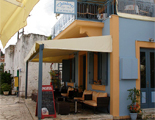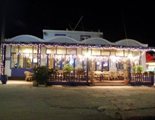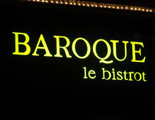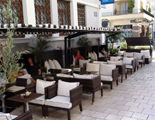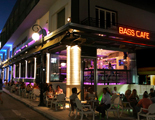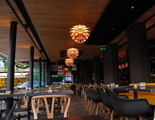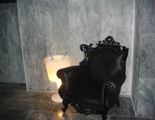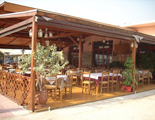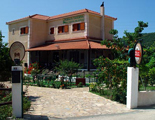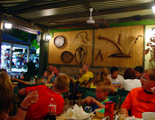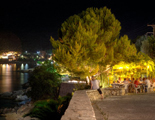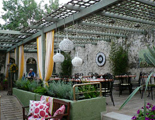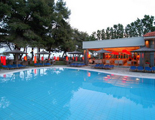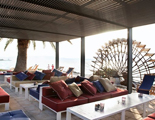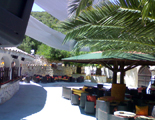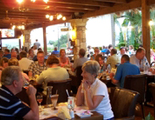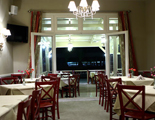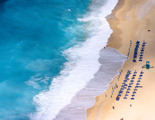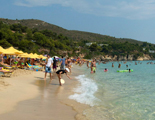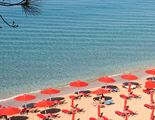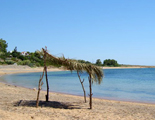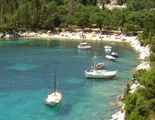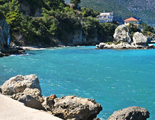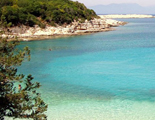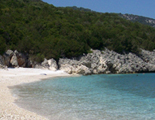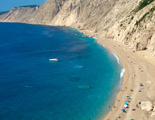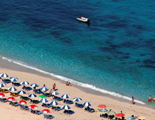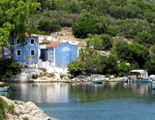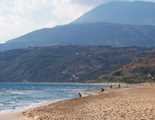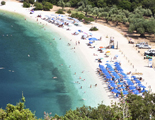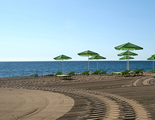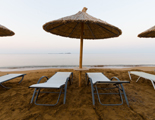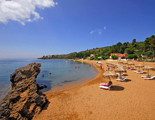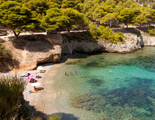 Kefalonia Travel Guide
Kefalonia Travel Guide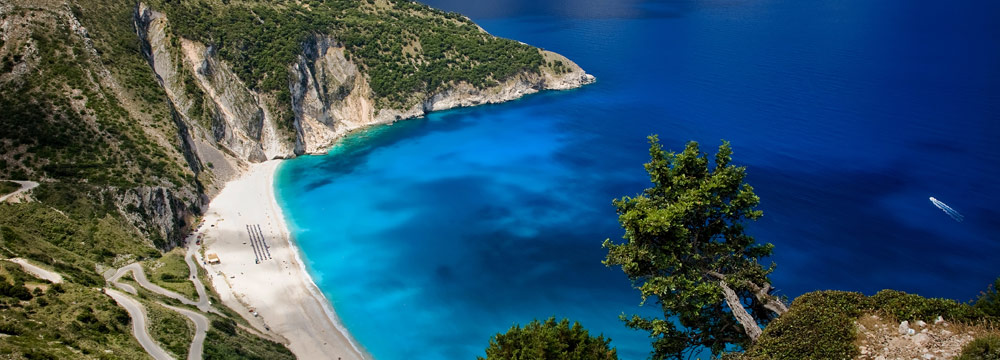
The first mentions for the island were recorded during the Persian Wars, where we find Kefalines participating in the battle of Plataies. In 434 BC the Kefalinian mighty ships participated in the naval battle of the Korinthians against the Corfiats, while during the Peloponnesian Wars they were in favor of the Athenians. However, even before that, evidence from settlements on the island prove its existence even in the Mesolithic, Neolithic, Early Helladic and Meso-Elladic eras.
In Skala and in Sami, archeologists found many stone tools made of flint or obsidian, while there is limited evidence from the first two Copper Eras. However, activity appears to be intense during the Mycenaean Era, due to the numerous arched or vaulted tombs found in Mazarakata, Metaxata, Lakythra, Diakata and Kontogenada.
The archeological museum in Argostoli houses many of those findings, especially from the tombs found in Mazarakata, Kokolata and Lakythra. The last astonishing finding was a small ancient theater in Fiscardo that accidentally saw the light of day during an excavation for the construction of a building.
Kefalonia was conquered by the Romans on 187 BC, even though there was a 4 month mighty resistance, especially from the state of Sami. However, the Romans won, sold the residents as slaves and looted the island which was used as a base of operations from which their naval forces could patrol the Ionian Islands and western Greece. In 325 AD, when Constantine reorganized the Roman Empire, Kefalonia became part of the Eparchy of Achaea. Unfortunately, during the Roman years, the island suffered from many attacks by pirates and barbarians (Vandals and Ostrogoths), while the wars between the Romans and the Africans also put it in great danger. Emperor Heraclius also attempted to reorganize the Roman Empire and divided the island in smaller Eparchies, aiming to achieve enhanced protection from enemies.
From 495 AD, Kefalonia belonged to the Byzantium, successfully defending the integrity and wealth of the Empire from pirate, crusader and Arab attacks coming from Africa. When the Normans descended to the Mediterranean Sea, the island started having many problems. On 1084, Roberto il Guiscardo, who was a mighty seafarer, defeated between Kefalonia and Corfu the united fleets of the Venetians and the Byzantines, in an attempt to conquer Kefalonia. His attempt was unsuccessful though and he actually died on his ship on June 17th 1085, in the port of Panormos, leaving his name to this small town as a heritage. Since then Fiscardo, namevariation of Guiscardo, became one of the most well-known towns of the island and definitely one of the most beautiful ones in Greece and Kefalonia remained under the Byzantine rule.
In 1103 Kefalonia was ravaged by the Crusaders, in 1125 the Venetians and the Genoese invaded the island, followed by the king of Normandy, Roger II. In 1185 William the Second managed to detach Kefalonia, Zakynthos and Ithaca from the Byzantines and created the county of Kefalonia-Zakynthos-Ithaca. John the 1st took over this county in 1303, after the death of his father, and, after marrying the daughter of the Despot of Epirus, received Lefkada as a dowry and became the Count of Kefalonia, Zakynthos and Lefkada.
After changing consecutive hands, Kefalonia was under the Venetian rule for almost 3 centuries (1500-1797). They say that when the Venetians took over the island, it was completely looted and deserted with merely 1.400 inhabitants. The Venetians depended on the nobility, whose families were registered in the prominent Libro d' Oro. Later, they established their headquarters in the castle of Agios Georgios and made it the island’s capital. However, the capital was ultimately transferred in 1757 in Argostoli, due to the latter’s strategic location.
On July 1797 the French invaded the island, formed a temporary democratic government and burned the Libro d’ Oro, the privileges and the titles of the Venetian nobility. The Frankish occupation lasted for 20 months, until the fleets of Russia and Turkey arrived in Argostoli in 1798. The creation of the Ionian State, under the rule of the Sultan and according to the Treaty of Istanbul on March 21st 1800, as well as the implementation of the Byzantine constitution that granted privileges only to those inscribed in the Libro D’ Oro led to massive riots in Kefalonia. On 1806 a new Constitution was established. However it was never implemented because the Ionian Islands were handed over to the Tsar. The second Frankish occupation lasted for about 3 years, because on 1809 the British fleet invaded Kefalonia, Zakynthos and Kithira, taking over their administration.
The British played a very significant part on the island’s development, starting from 1809. Commander De Bossé created a road network in Argostoli and in Leivatho, built the Bridge of Drapano, the Judicial Mansion in Argostoli, the Customs Office and the Lantern (Lighthouse) of Agioi Theodoroi. However, from 1848 the Ionians started rioting against the British occupation. In 1851 the British imposed many restrictive measures on the freedom of expression; nevertheless nothing could prevent the Unification of the Ionian Islands with the rest of Greece on May 1864.
From 1940 up until 1943, the Italians and the Germans conquered Kefalonia. However, on September 1943, a truly dramatic event took place. The Germans slaughtered more than 10.000 Italian soldiers. The German airplanes bombarded Argostoli and the nearby villages, leaving hundreds of victims behind, while many buildings and archeological sites were destroyed. And then came the Civil War till the mid ’40s.
Whatever was left from World War II and the Civil War was demolished by the terrible earthquakes of 1953. Kefalonia is located on the east of a tectonic plate, as all the Ionian Islands. The series of earthquakes that lasted for about 2 months dramatically changed the island’s development and history. Almost every building collapsed and hundreds of people were killed and injured. The northern part of the island, where Fiscardo is located, suffered much less damage from the 3.000 earthquakes and aftershocks. And this is why this is the only town that boasts many beautiful buildings of older architecture.
After 1953, the locals started migrating in an effort to restore their economic status and this led to the island’s economic, social and cultural recess. During the ’80s the island suffered a significant population decrease. However, in 2001 the Prefecture of Kefalonia appeared to be the fastest growing community in the country. Today, Kefalonia is one of the most popular holiday destinations in Greece, chosen by many celebrities, especially after the movie Captain Corelli’s Mandolin that was shot there, such as actors, singers and politicians from around the world that arrive on their luxury yachts and enjoy the incredible turquoise blue waters, the pure white pebbles and the delectable cuisine.
The island of Kefalonia first appears in Homer’s Iliad and Odyssey, under the name Defkalion and as part of Ulysses’ kingdom. Like with everything in the Greek Mythology, no one really knows how the island got its current name, since there are various theories. Some say that the name derives from the word “Kefali”, which in Greek means “Head”, implying the fact that it’s the biggest of the Ionian Islands. According to another version, the name derives from Kefalonia’s first king, who, according to some Myths, was Kefalos.
Kefalonia has a history that goes way back through the Ages and its past is interwoven with many myths. More specifically, the existence of Paleolithic findings implies that the island’s history started 50.000 years ago, when it was united with Ithaca, as well as with the mainland.
Kefalonia and the rest of the nearby islands were linked to a powerful Mycenaean naval kingdom, whose name still remains unknown. Some archeologists support that a specific location that belonged to that kingdom was “Taphos”, nowadays there is a village named Taphios. This theory is based on Apollodorus’ narrations. He said that the island’s first king was Taphius, who was the son of Poseidon and Hypothoe. The first settlers of Taphios were the Taphians or Teleboans.
When the city of Kefalonia became powerful and demanded part of that Mycenaean kingdom, their king Electryon refused, so the Taphians reciprocated by stealing his flocks. Electryon never forgave them for that and when the king of Thebes, Amphitryon, asked his daughter in marriage, Elecrtryon agreed on one condition. That Amphitryon would take revenge on his behalf. Amphitryon together with Cephalus and Eleius were sent to conquer the Taphian territories. During the battle, Amphitryon lost his immortality and returned to Thebes, handing over the loots to Cephalus –who supposedly gave his name to the island.
According to Aristotle, Cephalus was barren and he sought for advice from the Oracle of Delphi. She suggested that he should have intercourse with the first female he’d see. Hence! This female was a bear. This is how Arceisius, future king of the Ionian Islands, was born. His son, Laertis, and then his grandson, Ulysses, were heirs to the kingdom.
The island also got the name Tetrapolis, from the names of Cephalus’ 4 sons. Palae covers the entire western peninsula of the island (today’s Paliki), Cranae was built in Koutsavos, where there are remnants of Cyclopean Walls, Pronnoi in the southeastern part of the island and Sami, which was built on two hills, right above today’s town. These 4 cities were autonomous and had their own coins.
Nevertheless, according to another version, the name of the island came from another source. Many clay inscriptions mention a population named “Kefalines” or “Kefalanes”, who resided in the western part of Greece. In Homer’s era, Sami was first inhabited by Aggaios, a descendent of Zeus. Aggaios, during the Pre-Homeric era moved to Kefalonia from the Peloponnese. The abundance of evidence from that era led many to believe that the Homeric Ithaca is actually Kefalonia. They also say that Ulysses and his companion Penelope were old deities of Arcadia. This is why they believe that Achaioi from Arcadia moved to Kefalonia, bringing their own heroes and gods there. Besides, as it’s known, Ulysses’ populace was Kefalines and they owned Ithaca, Zakynthos, Akarnania and Sami. The name Kefalinia is mentioned by ancient writers, such as Herodotus on 450 BC. So, according to this version, Kefalines gave Kefalonia its current name.
It’s also worth mentioning that the inhabitants of Kefalonia worshiped the Olympian gods and this proves that they were connected to the mainland. Coins found on the island depict Zeus, Poseidon, Athena, who also protected Ulysses, and Demetra.
How can you choose among all these places definitely calling for a visit? Kefalonia is filled with ancient monuments, sanctuaries, castles, old churches, monasteries, caves and old tombs. Find here below a list with the most beautiful and not-to-be missed sites in Kefalonia.
Agios Gerasimos is the patron saint of the island and the monastery, where his body is kept, is located in Omaloi. Agios Gerasimos departed on August 15th 1579 and the Patriarchate declared him as Saint on 1622.On October 10th 1581 they dug up his body, which was intact, giving off a pleasant scent. The procession of his body on August 16th is a major celebration of Kefalonia and it attracts thousands of people.
The lighthouse, also known as Lantern (“Fanari” in Greek), is located in Lassi, near Argostoli. It was built on 1820 based on a British architectural design. Unfortunately during the earthquakes that stroke the island in 1953 it was totally destroyed, but was later reconstructed according to the original blueprint.
The Fortress of Agios Georgios is located at the village Peratata on a 300 m altitude and was probably constructed during the 12th century AD by Byzantine Emperors. It’s about 16.000 m2 and its surrounding walls are approximately 600 m long. Inside the walls there were public and private buildings, churches, food and ammunition warehouses, barracks, hospitals, prisons and water tanks. Visitors will also see the remnants of the catholic church of Agios Nikolaos and a tunnel that led from the castle to the lagoon of Koutavos and it was used in case of emergency exit. This castle was actually the capital of the island till 1757, when Argostoli became the new capital, but it was heavily damaged during the earthquakes of 1636, 1637 and 1953.
The Archeological Museum in Argostoli houses various antiquities found on the island. Among its exhibits are various items from the prehistoric and the roman years, but it mostly features findings from the Mycenaean era: ancient coins, copper swords, stamps, precious stones, tools of the Paleolithic man and ceramics of the Geometrical and the Archaic era.
For more information about entrance fees and opening hours, please call at +30 26710 28300.
This Monastery is dated back to the 18th century when in 1772 two shepherds and their maid found the miraculous icon of Virgin Mary. The Monastery is located at Agrillia region, near Sami, and it has an incredible view to the beach of Antisamos and Ithaca.
This is a rare geological phenomenon. This cave is located in Karavomylos, about 2 km from Sami. The ceiling of the cave’s main hall has collapsed, creating two sections. One is open air and the other is roofed. The entire length of the cave is about 160 meters and its maximum depth 39 meters. In the center of the lake-cave which is open air, there is a tiny islet, where archeological findings verify the worshiping use of this cave in the antiquity. This is why Melissani is also called the Cave of the Nymphs. Even though the tour doesn’t last long, it’s still beautiful to watch all these different shades of blue in the water. The cave is open daily until late at night. Do not miss this out since the spectacle of the lake in a cave with no ceiling and the sun rays radiating in its waters it is just superb! For more information call at 26740 22997.
This cave is located a few kilometers away from the port of Sami. It’s 45 meters wide, 21 meters deep and 9 meters high and it’s divided in 2 sections, out of which only one is accessible to the public. The main hall is used for many cultural events, since it has excellent acoustics, and it can accommodate up to 500 people. The artificial lighting together with the reflections of the stalactites creates a unique visual panorama.
This historic library is located on the western part of Lixouri and it is housed in the pre-earthquake mansion of the Typaldos-Iakovatos family, restored in 1984. It consists of 14 rooms, beautifully decorated, and it boasts a collection of 30.000 volumes, a big part of which is from the 16th, 17th, 18th and the 19th century. The Museum hosts manuscripts, ecclesiastical vestments, old furniture, paintings, 36 priceless icons and3 gospels handwritten on vellum dated back to the 10th, 14th and 15th century.
For more information about entrance fees and opening hours, please call at +30 26710 91325.
This Museum is housed in the imposing building of the homonymous Library, founded in 1962. The archives depict the island’s history starting from the 15th century till 1848 and its founding aimed at preserving the memories of Kefalonia before the earthquakes of 1953. It boasts a collection of historic documents, paintings, personal artifacts, porcelains, silver decorative items, old furniture, photographic archives, ecclesiastical utensils, icons, coins, musical instruments and many more.
For information on entrance fees and opening hours, please call at +30 26710 28221.
These very important tombs verify the existence of a substantial Mycenaean settlement in this area. Amongst the archeological findings is rare jewelry of Mycenaean art.
The remnants of a roman villa of the 3rd century BC in the location of Skala which are definitely worth a visit. Mosaics in mint condition, with complex reenactments were brought to light after years of archeological excavations.
The archeological excavations in this area brought to light the biggest arched tomb ever found in western Greece. Amongst the unique findings are jewelry and a stamp, verifying once again the existence of an important Mycenaean metropolitan hub.
Mount Aenos is an exceptional natural preserve boasting a forest of the unique black firs of Kefalonia (abies cephalonica). Aenos became widely known as the Monte Negro of Greece due to the dark color of the trees that seemed black when seen from far away. This beautiful National Park hosts a great variety of flora species and a rich fauna including reptiles and birds, such as the hawk, the woodpecker and the blackbird. The most important mammal found here, but unfortunately is under extinction, is the famous Aenos wild horse, which belong to the Pindos breed and is small and very strong.
Location: Skala
CLIMATE
The Ionian Islands enjoy a typical Mediterranean climate. Kefalonia has long, hot summers, with abundant sunshine and temperatures that reach up to 35 degrees. There are only a few rains during summer months and the nights are somewhat cooler. The islands on this part of Greece do not experience the famous “meltemia”, summer winds, very usual in the Aegean. Thus, the temperature does not considerably vary. However, there are beaches, especially on the northwestern side of the island that experience extremely strong winds and underwater streams that require attention in swimming. A good example is the famous beach of Myrtos.
Spring and fall are certainly the ideal months for sightseeing and walking, since temperatures vary between 15 and 20 degrees, facilitating any kind of sports and even swimming. The winters are mild, with temperatures that won’t drop below 9 degrees. The heavy rainfalls, the high humidity and the gentle winds are responsible for the lush green landscape of Kefalonia.
TELEPHONE
The national prefix for Greece is +30 if you are calling from abroad.
The area codes for Kefalonia are 26710 (for Lixouri and Argostoli) and 26740 (for Sami and Fiscardo) and the local phone numbers have 5 digits. If you want to place a call to another country, you have to start by dialing this country’s national prefix (i.e. for Germany is 0049, for England is 0044, etc.) and then continue with the desired area code and number.
CURRENCY
The currency used is Euro (€). Euro Coins: 1 and 2 euro coins (golden and silver color) 10, 20 and 50 cents (golden color) 1, 2 and 5 cents (copper color) 1 euro = 100 cents/centimes. The banknotes come in 5, 10, 20, 50, 100, 200 and 500. Please bear in mind that it’s not easy to get change from the 100, 200 and 500 banknotes.
BY AIR
The airport is located 9 kilometers off the island’s capital, Argostoli. There are daily flights between Athens and Kefalonia throughout the year, as well as numerous charter flights between the island and major European cities during the summer months. Additionally, during the summer there are flights between Kefalonia and other cities in Greece. The airport can be easily accessed either by private cars or by bus and taxi.
Athens International Airport Eleftherios Venizelos www.aia.gr
Olympic Air: For accurate timetable and ticket costs visit Olympic Air website www.olympicair.com
Tel.: 801 801 0101/+30 210 3550500
Kefalonia Office Tel.: +30 26710 28808, +30 26710 28881
BY CAR
If you choose to visit Kefalonia with your car, you have three choices. You can drive to Patras (216 km), Kyllini, trip lasts about 3 and a half hours, or Astakos in Aitoloakarnania. Patras, Kyllini and Astakos can be accessed via the Athens-Patras National Highway, if you are travelling from Peloponnese, Athens or east-central Greece. If you are driving from northern Greece you need to take Egnatia Odos towards Igoumenitsa and then drive southwards.
If you are driving through the Athens-Patras highway and you want to take the ferry from Astakos, you need to pass the bridge of Rio-Antirio and continue through Mesologgi towards Astakos.
Once you reach Patras, Kyllini or Astakos you take the ferry to Kefalonia. The journey’s time depends on the departure point. For more details, please see the dedicated section for boat routes and timetables below.
BY BUS (KTEL)
There are daily departures from Athens to Kefalonia, from Kifissos Terminal Station in Athens. The bus will go from Athens to Kefalonia (through Kyllini or Patras) and will reach its final destination, Argostoli, within about 6,5 hours. Kefalonia features the ports of Sami, Poros or Argostoli.
KTEL information in Athens - 100 Kifissos Avenue, +30 210 5129498
Argostoli Bus Station – Downtown, +30 26710 22281
For more information, please visit www.ktel.org
BY BOAT
There are daily boat connections between Kefalonia, Peloponnese and the district of Sterea Ellada.
- From Astakos region, Sterea Ellada
There are daily boat routes from Astakos to the port of Sami in Kefalonia that last approximately 2,5 hours.
For accurate timetable and ticket costs call here:
Kefalonia Port:+30 26710 91280
Port Authorities of Astakos: +30 26460 41052.
- From Patras
There are daily boat routes from Patras to the port of Sami in Kefalonia that last approximately 3,5 hours.
For accurate timetables, prices and reservations please visit: www.strintzisferries.gr
Port Authorities of Patras. Tel.: +30 2610 341 002
Port Authorities of Sami. Tel: +30 26740 22031.
- From Kyllini
There are daily boat routes from Kyllini to the port of Poros in Kefalonia that last approximately 1,5 hours. There is also a connection between Kyllini and Lixouri – Argostoli, but only during the summer months.
For accurate timetables, prices and reservations please visit: www.ionianferries.gr or www.strintzisferries.gr
Port Authorities of Kyllini. Tel: +30 26230 92211
Port Authorities of Poros. Tel: +30 26740 72460
Port Authorities of Lixouri. Tel: +30 26710 91205.
Kefalonia is also connected with the rest of the Ionian Islands.
- From/to Kefalonia to Lefkada and Ithaca
There are boat routes between Lefkada and Fiscardo, Ithaca and Fiscardo, as well as Ithaca and Sami.
For accurate timetables, prices and reservations please visit: www.strintzisferries.gr
Port Authorities of Fiscardo. Tel: +30 26740 41400
Port Authorities of Ithaca. Tel: +30 26740 32909.
- From/to Kefalonia to Zakynthos
This connection applies only during the summer months (May to October) and takes place twice a day. The journey, that lasts approximately 1 hour, is between the port of Pessada in Kefalonia and the port of Schinari in Zakynthos.
Port Authorities of Argostoli. Tel: +30 26710 22224
Zante Ferries: www.zanteferries.gr, Tel: +30 26710 91280.
- From/to Kefalonia to Corfu
You can travel between Kefalonia and Corfu with a flying dolphin.
For accurate timetables, prices and reservations please visit: www.ionian-cruises.com Petrakis Ferry Lines. Tel: +30 26610 31649 (based in Corfu).
- There is also a boat connection between Argostoli and Lixouri. The boat leaves every half an hour, the trip lasts 20 minutes and it costs 1.70€ per passenger and 4.30€ per car. For more information you can call the Port Authorities of the above cities or visit the website www.ionianferries.gr.
- Finally, during the summer months there is a boat connection between Kefalonia and Brindisi in Italy, with Endeavor Lines Ferries.
For accurate timetables, prices and reservations please visit: www.endeavor-lines.com.
BY CAR
If you choose to visit Kefalonia using your car, you have three choices. You can drive to Patras (Athens-Patras 216 km), Kyllini (Athens-Kyllini 286 km) or Astakos in Aitoloakarnania. Patras, Kyllini and Astakos can be accessed via the Athens-Patras National Highway, if you are travelling from Peloponnese, Athens or east-central Greece. If you are driving from northern Greece you need to take Egnatia Highway towards Igoumenitsa and then drive southwards.
BUSES
Kefalonia’s road network is good and so is its public transportation system. The main Long Distance Bus Terminal (KTEL) is in Argostoli and from there you can get information about itineraries and prices. The bus itineraries cover almost the entire island and the tickets are not expensive. There are 4 daily rides between Argostoli and Sami and 2 between Argostoli and Fiscardo.
TAXI SERVICE
A taxi can be used for short or longer distances. The main taxi station is in Argostoli, on Vlavianou Square. However, you can also hail for a cab in the main streets or central places. The fares are fixed between the capital city and the most popular destinations, but you can also check before you get onboard. In the main taxi stations you will also find a board with indicative fares for every destination. Additionally, you can also call for a cab at the following numbers:
Argostoli – Tel.: +30 26710 28545
Lixouri – Tel.: +30 26710 91459, +30 26710 91524
Poros – Tel: +30 26710 72340, +30 26710 72329
Skala – Tel.: +30 26710 83231
Fiscardo – Tel.: +30 26740 51496
RENT A CAR OR A MOTORBIKE
Kefalonia is the biggest of the Ionian Islands covering an area of 904 km². There are many attractions, secluded beaches and monuments waiting to be explored, thus a car or a motorbike is always the most practical and convenient way to get around. There are numerous car rental agencies on the island. However if you are planning on visiting the island during summer months, it’s better to make a reservation in advance.
Remember that in order to rent a car or a scooter, you need to be 21 years old (for some companies you need to be 25) and you definitely need a valid driving license. Full insurance is optional. Make sure you check the condition of the car beforehand. If you sign for its mint condition, this is how you must return it, otherwise you will be charged with damages, unless you included full insurance in the initial, mutually agreed price. The agency’s representative should take note of any damages and make a mark on the contract. Also, you need to return the car with as much gas as it had when it was delivered to you. Bear in mind that no agency is allowed by law to withhold your driving license or ID card. These can only be photocopied, if necessary (very few agencies do), and then delivered back to you. You should carry them at all times in case the police or any local Authorities request them.
The terrain of the island is mountainous, with many purely agricultural areas, which means that tractors or other vehicles might appear out of nowhere or even animals or pedestrians. Needless to say that you should be extra careful and experienced, especially if you are riding a motorcycle or a scooter. Do not violate the speed limits and do not park where not allowed. The municipal and the traffic police will grant you with a ticket. Remember that even though it’s a rent car or motorbike, you will still have to pay for the ticket.
Distances between the most known villages and towns in Kefalonia:
Sami – Lixouri 42 km
Poros - Lixouri 70 km
Fiscardo - Lixouri 50 km
Argostoli - Lixouri 30 km
Pessada – Argostoli 15 km
Argostoli - Fiscardo : 50 km
Argostoli - Poros : 43 km
Argostoli - Skala: 40 km
Argostoli - Sami : 24 km
Argostoli – Agia Ephemia: 36 km
BANKS & ATMs
You will have no problem getting money from an ATM, since every bank has one. There are many bank branches on the island, as well as several ATMs scattered around, which operate 24/7. Remember that in order to get money you need to have a card linked to the PLUS, Cirrus or Maestro networks. Check with your local bank for details.
The banks are open daily, from Monday to Thursday, from 8am to 2.30pm and on Fridays from 8am to 2pm. No bank is open during the country’s national and religious holidays. You can also use every major credit card (AMEX, Visa, Mastercard and Diners) during your transactions with hotels, stores and restaurants. Entrance to archeological sites, bus tickets, taxi fares or entrance to bars and clubs cannot be paid with a credit card.
MONEY EXCHANGE
If you are travelling from outside the EU, you can carry traveler’s cheques. All banks exchange almost every major currency and traveler’s cheques; the commission is always lower for cash. The Post Office can also exchange cash, but not traveler’s cheques and usually charges lower commissions than banks. Travel agencies and 5 star hotels exchange foreign currency and traveler’s cheques, but usually with a higher commission. There is also a dedicated exchange kiosk at the local airport, as well as at the Athens international airport Eleftherios Venizelos.
POST OFFICE
The Greek Post Office is called ELTA and you will find branches in the biggest towns of the island. However, you will track down many post boxes in every town and outside 5 star hotels. Boxes might be YELLOW for regular mail or RED for URGENT mail. If you wish to send REGISTERED mail, you need to visit the nearest Post Office and don’t forget to get a receipt.
ELTA Argostoli – 19 D. Konstantinou Street, tel.: 26710 22312
ELTA Lixouri – D. Lavragka Street, tel.: 26710 91206
ELTA Sami – Tel.: 26740 22012
ELTA Poros – Tel.: 26740 72644
POLICE STATION
Do not hesitate to call the Police in case of an accident or a criminal act against you or someone else. If you have a problem with your hotel, you can also contact the Tourism Police (tel.: 26710 22815). There are many police stations around the island and you will see officers inspecting the streets of all major towns at all hours.
- Emergency telephone line: 100• Police Station Argostoli: 52 I. Metaxa Str., +3026710 22200
- Police Station Lixouri: +30 26710 91207
- Police Station Skala: +30 26740 83100
- Police Station Poros: +30 26740 72210
- Police Station Fiscardo: +30 26740 41460
- Police Station Sami: +30 26740 22100
- Argostoli Municipal Police: +30 26710 24309
MUNICIPALITY OF KEFALONIA
Municipality of Kefalonia. Tel.: +30 26710 22120, 29130 and 29131
- Argostoli Customs: +30 26710 22335
- Airport Customs: +30 26710 41150
- Lixouri Customs: +30 26710 91420
- Fiscardo Customs: +30 26740 41250
- Greek Tourism Organization: +30 26710 22248
- Airport: +30 26710 41511
- National Bank of Greece in Argostoli: +30 26710 25191
- Emporiki Bank in Argostoli: +30 26710 22334
- Alpha Bank in Argostoli: +30 26710 25181
INTERNATIONAL PRESS
You can find International Press (magazines and newspapers) almost anywhere around the island.
HEALTH
- General Municipal Hospital in Argostoli: +30 26710 24641
- Mantzinateio Hospital in Lixouri: +30 26710 91233, +30 26710 92222
- Medical Center Sami: +30 26740 22222
- Regional Medical Center Agia Thekla: +30 26710 97208
- Regional Medical Center Karavados – Tel.: +30 26710 69387
- Regional Medical Center Keramies: +30 26710 69101
- Regional Medical Center Skala: +30 26740 83222
PHARMACIES
There are many pharmacies around the island and they are open in the following days and hours:
Monday and Wednesday: 8.30am - 2.30pm
Tuesday, Thursday and Friday: 8.30am - 2.30pm and 5.30pm - to 8.30pm.
Saturdays & Sundays: Closed
However, you will find few pharmacies which are open during the weekend and throughout the night. A list of those pharmacies can be found at any time on any pharmacy’s window around the island.
Argostoli Pharmacies: +30 26710 24015, 23245 and 24795
Lixouri Pharmacies: +30 26710 91490, 93548 and 93675
Mirtos was voted as one of the best beaches in the world and it is the trademark of the island. Its exotic natural beauty with the transparent waters, the dazzling white sand and pebbles, the steep cliffs that submerge in the sea, the consecutive Blue Flag awards and the amazing sunset has justifiably travelled around the world. This beach cannot be missed.
Makrys Gyalos is a cosmopolitan beach, only 3 kilometers from Argostoli, visited by hundreds of people every day. It's fully organized, with umbrellas, sun beds and lifeguards on duty. At Makrys Gialos you will have the chance to try water sports or relax on one of the many beach bars, taverns, restaurants and small cantinas.
We could say that Platys Gyalos is the better other half of Makrys Gyalos while it is actually its extension. They are both known for their azure waters and the golden sand. It has been awarded with the Blue Flag and it's fully organized.
Vatsa is actually the beach everyone is looking for but very few are able to find! This is a sort of a local legend. It's an untouched, almost primitive landscape, mostly accessible by sea, while lunch in the only local tavern -owned by a somewhat peculiar man- will certainly be the highlight of your vacations.
This is one of the most well known beaches of the island. It's sandy and though not very long boasts amazing blue waters. The entire area has an excellent tourism infrastructure, with many hotels, rooms to let, stores, restaurants and traditional taverns. You can also take a walk in the nearby mountainous area.
This is a rather unknown beach, only 5 minutes by car from Fiscardo. It is not organizedand ideal for those who love pebbly beaches. Foki mostly attracts people who look for clamness and peacefulness far away from crowds. The trees that reach all the way to the shore, give waters this amazing, dreamy emerald color while offering the most cooling and rejuvenating natural shade.
Dazzling white pebbles, excellent infrastructure and rejuvenating waters. Being one of the most beautiful beaches of the island, Poros will just enchant you. Here you will find umbrellas, sun beds, beach bars, restaurants and a small market. This 2 kilometers long beach is surrounded by smaller coves with sandy shore.
Emplysi is a charming beach, near the picturesque Fiscardo. Since the coast is full of thick pebbles, you will definitely need a sunbed in order to comfortably enjoy the sun. The scenery is ever green and the deep waters are crystal clear. Emplysi is a rather quiet place, sheltered, but not organized.
Koutsoupia is yet another small, secluded paradise, accessible only by boat. The evergreen landscape, the thin white sand and the turquoise blue waters will make you think you are in some exotic coast in the Caribbean. Enjoy the beach and the sun away from the bustling crowds!
Ammes is indeed like a nice warm, sandy hug! It's located near the airport and about 10 kilometers away from Argostoli. The crystal clear waters and the fine, golden sand attracts hundreds of locals and tourists every day. No one leaves before sunset, when the waters take a deep reddish color that takes your breath away!
Way before you even get to the beach, you will feel the magic. The 10 km road trip from Lixouri will take your breath away. The small pebbles will massage your feet, the rejuvenating breeze will caress your face and you will simply enjoy the turqoise, clean waters. Petanoi is fully organized and easily accessible.
Atheras is a quiet beach with white sand and emerald waters. Even though it's about 30 km away from Lixouri, the road is very good and it is the preferred choice for many families due to its shallow waters. In the area, you will also find numerous scenic seaside taverns, where you will enjoy the fresh fish, seafood and well cooked meat!
This is the beach that the locals are unsuccessfully trying to hide from the visitors. It used to be accessible only by boat, but now things have changed. The only thing that stands between you and this secluded paradise are the 400 stairs you need to climb down. The hot sand has nestled in between the imposing rocks and the sunrays breathe life in the sparkling waters. The entire peninsula of Paliki is unspoiled, yet welcoming!
This is an exotic, secluded and isolated beach on the southern tip of the island. It's located in the middle of nowhere, but you will find it on the way to Skala. Just take a right turn before reaching the village of Ratzakli. The beach is easily accessible, however its most beautiful and somewhat shady spots can only be found by going on foot. Ideal for swimming and relaxation in a quiet natural environment, it is also a refuge for the Caretta-Caretta turtles.
This is yet another famous beach. Antisamos became known by the movie Captain Corelli's Mandolin, since some famous scenes were shot there. The ever emerald blue waters, the small white pebbles, the amazing view, the trees that reach all the way to the water and the bustling beach bars are only few of its attractions.
This is a 7 kilometers beach! A favorite meeting point for water sports aficionados and not only! Skala is famous for offering unforgettable moments and romantic walks. It's organized, sandy, with deep azure waters. In the homonymous village, you will have the opportunity to see up close the Roman Villa of the 3rd century BC with the astonishing mosaics, as well as an ancient temple dedicated to Apollo.
Xi is an "alternative" beach that will make you want to come back for more. They say its soil contains therapeutic elements and many people that visit this place cover themselves with mud! Nevertheless, it has a superb natural beauty, numerous beach bars and it's well organized.
Lepeda is a beautiful family beach with silky white sand and transparent blue waters. It's located just 2 kilometers from Lixouri and it's ideal for those looking for an organized beachwith shallow waters. The local picturesque tavern has delicious, fresh fish and seafood.
The beach of Assos is located at about 10 kilometers from Fiscardo. It's covered with small pebbles, however the seabed is covered by golden sand. There are many scenic coffee places nearby where you can enjoy a cold beverage or a frappe overlooking the dazzling sea! You can also rent a small boat and tour the nearby secluded beaches.
The cuisine of the Ionian Islands is delectable and healthy while strongly influenced mostly by the Venetians. The distinctive flavors and scents, the traditional local products, the imaginative combinations and the genuine love of the locals for their gastronomy lead to the creation of some of the most famous Greek dishes. Kefalonia’s soil is rich due to the heavy rainfalls and this is why the island produces many agricultural products, such as olive oil, olives, wine, fruits, vegetables and dairy products. The local cuisine consists of all the main ingredients of the Mediterranean and Ionian diet, like meat, fish, fruits and vegetables.
If you are in Kefalonia, you should definitely try some local products, like the famous Feta cheese, the ham, the amazing thyme honey, cookies with anise, the delicious Robola wine (Protected Name), the must cookies etc.
Among the most famous local recipes are:
This is an exclusive local dish made with garlic, potatoes purée and the broth from an octopus that has been broiled.
Rabbit cooked in tomato sauce and boiled with the famous red and sweet wine Mavrodafne.
The pies are probably the island’s cuisine trademark. Made from handmade dough and various stuffing, like rice and meat, leek and spinach, vegetables, cod and octopus.
This is a soup with peas, salt, pepper and olive oil.
Eggs with tomatoes, fried in local olive oil, salt and pepper.
Bread slices, baked or fresh, with olive oil and oregano.
A dish made of two kinds of local fish, pasta, onions, garlic and a thick sauce.
This is very popular amongst the vegetarians, since it’s basically spinach cooked with rice and lots of lemon sauce.
This is the most delicious fish soup, prepared with the broth of local fishes.
Lamb baked in aluminum foil and filled with green peppers, feta cheese and lots of pepper.
A sweet made of dough and cream filling of eggs, sugar and milk.
A sweet snack made with almonds and sugar.
A caramelized sweet snack, made with sesame and local honey.
A cake with almonds, flour and eggs.
no results
There are numerous religious and cultural events taking place in Kefalonia every year. Find below the most important ones
- 21 May – Celebration for the Unification of the Ionian Islands with Greece (1864)
- 11 July – The Festival of Agia Effimia
- 27 July – The Festival of Agios Panteleimon in Sami
- 15 August – Wine Festival in Palliki
- 16 August & 20 October – The procession of Agios Gerasimos at Skala and Omalos respectively, with food and drinks
- New Year’s Eve in Lithostroto – A pre-earthquake custom
- February - Carnival festivities in Argostoli, Skala and Poros
- June & July – Navy week, with celebrations, parades and laying of wreaths at all cenotaphs
- July – Theatrical festival in Argostoli, with many theatrical performances
- July & August – “Eortia” in Sami. Festivities with concerts, exhibitions, shows and dancing
- August – Snake Festival in the church of Virgin Mary in Markopoulo
- August – Robola Festival in Fragata. This is the biggest Wine celebration on the island that takes places since 1979
- September – Musical festival of Lixouri
- Christmas eve – “Rimnes” (musical poems), a substantial part of the island’s cultural heritage
Kefalonia is an all-around spectacular island. It seems that there are a lot of peculiar geological phenomena, secrets, legends and religious-related weird occurrences. The mountainous ground combined with the intense presence of the aquatic element generously offers this island a rare and distinctive beauty. Cycladia has managed to unveil the well hidden secrets of Kefalonia…
If you are nature lovers, then Kefalonia is definitely your paradise. There are numerous hiking trails you can follow to discover the wild natural beauty of the island. If you happen to be in the natural park of Aenos Mountain and hear horses galloping, don’t be scared. It’s not your imagination, although you might think you are starring in the Lord of the Rings movie! There are wild horses living around the Monastery of Zoodochos Pigi, at an altitude of 1.300-1.500 meters. These horses are adjusted to the exceptionally adverse conditions, due to the climate and the mountainous territory. However, it will be difficult to track them down, since they avoid human presence and, unfortunately, they are nowadays almost extinct.
If you happen to drive from Argostoli towards Sami, you will see a sign that leads to the church of Agia Varvara. Don’t ignore it! It’s not a typical Greek chapel. Through time, a river’s flow shaped underground trails and the rocks created a small, peculiar opening that looks like a hug. The small and simple church of Agia Varvara was built inside this opening. This shouldn’t be missed!
Leaving aside the rumor that has the inhabitants of Ionian Islands a little bit exaggerated than the rest of Greeks, the story of Kounopetra, a rock that moves by itself, seems to be real! This solid, grand rock in the district of Paliki appeared to have a rhythmical and constant movement, which couldn’t be explained by anyone including the most renowned scientists from all over the world. It is believed that ships from the British fleet were trying to pull the rock with chains with no eventual success. The 1953 earthquakes unfortunately put an end to the mystery. Since then, Kounopetra (which in Greek means wobbling rock) hasn’t moved an inch.
Kefalonia is, without a doubt, an island of mysteries. A popular mystery is the appearance of agiofida, which in Greek means “holy snakes”, every year between August 6th and August 15th (Assumption of Virgin Mary). This phenomenon takes place in the village of Markopoulo, in the remnants of the old bell tower, which is dedicated to Virgin Mary, and in the church of the mountainous village of Arginia. On August 6th the small snakes that are harmless and non-poisonous appear –as if from nowhere- and they fill the church’s interior. They disappear on August 15th. The weirdest thing is that these snakes have a small cross on their head and this is why they are called holy snakes. According to those who have attempted to explain this phenomenon, this is a rare snake spieces that breeds in this area. So their appearance and disappearance has to do with their breeding season. They say that the loud sound of the bell wakes them up and makes them come out of their nests into the chrurch.
In every island the locals choose one place, one beach or one secret spot and try their best to keep it hidden from the tourists. Well, the secret finally ends up out in the open! This new gem is a secret beach resembling to Myrtos: the beach of Platia Ammos. The locals, in order to keep it away from the crowds, started dismantling every road sign leading to this amazing, unspoiled paradise, but officers from the municipality of Paliki insist on replacing these signs! It sounds incredible but the 400 stairs that lead to the beach do not discourage the tourists who have actually discovered it. This is a truly exotic, secluded beach with calm and transparent waters. A few years ago it was accessible only by boat, but not anymore. Keep in mind that there is no cell phone signal down there!
The beach of Myrtos is by no means a secret. On the contrary it is considered as one of the best beaches in the world. However, the entire eastern part of Kefalonia, near Myrtos, is filled with small caves, coves and secluded beaches with white sand or pebbles, accessed only by sea. The scenery cannot be described in words. The waters are turquoise blue and rejuvenating, fishes are swimming right next to you, while the privacy found in one of those small hidden paradises can offer you unforgettable moments!
In the district of Pylarou there is a village called Makryotika. This village boasts a traditional bakery that makes the tastiest bread ever. The locals and those who know, never miss it. The scent of the freshly baked bread, the warm, traditional ambience and the people there travel you in another era!
Katavothres are included in the most peculiar geological phenomena of the island. Katavothres are basically underground tunnels, next to the sea, where water comes in and out. Based on evidence, the water seems to disappear in these openings which are located in Agioi Theodoroi, just 2 km from Argostoli. The water crosses the underground tunnels underground and ends up in the cave of Melissani, located at about 15 km away. The water continues its route and ends up at the sea at Karavomilos village, within two weeks.. The most prevalent theory on this is that the underground consists of rocks and materials that have been subjected to erosion and, thus, the water penetrates through small tunnels and caves and ends up to different locations of the island. In the past watermills had been built to take advantage of theis phenomeno but after the earthquakes they were abandoned. The underground itinerary of the water has been verified by adding purple dye to the water entering these sinkholes so its course was monitored and clearly obvious as the purple liquid finally reached Karavomilos village.
Xi is an alternative beach. It’s said that its soil has therapeutic quality and this is why thousands of people arrive here and cover themselves with this distinctive mud. You should at least try it once. Moreover, from the beach of Xi you will find the unpopulated Vardianoi islets, ideal for those who seek a sanctuary, away from the bustling crowds, and for those who love fishing.
Kefalonia is a big island with a large market that provides almost anything one may need. Argostoli, Lixouri, Skala, Fiscardo, Poros and Sami have many stores, with various products. From clothes to shoes, from decorative items to folk art and from kitchen ware to computers.
Sklavos Winery
Long family tradition in wine production.
Kehrionas, Lixouri
Tel.: +30 26710 91930
Garbis Jewelry
Unique jewelry collections and decorative ornaments.
78 Ant. Tritsis Str., Argostoli
www.garbisjewellers.com
Folk Art Aimilia
Authentic creations, bronze and ceramic artifacts, glass and wood.
Fiscardo
Tel.: +30 26740 41030
Porto di Guiscardo
Jewelry, clothes, traditional artifacts and decorative items.
Fiscardo
Tel.: +30 26740 41159
Mavroeidis
Sweets, pastries and mandoles since 1918.
Argostoli branch: 16 Lithostroto St., Tel: +30 26710 22021
Lixouri branch: Central Square, Tel: +30 26710 91246
www.mavroidis.gr
Voskopoula
A pastry and mandola shop since 1910 in Argostoli. Also operates a small museum where the sweets are being produced in Pessada.
Pessada: +30 26710 69832
Argostoli shop: 3 Lithostroto St., Tel: +30 26710 25434
www.voskopoula.gr
Bookstore Kyvos
A nice bookstore in Argostoli featuring a great variety of books.
www.e-kivos.gr
Cooperative of Robola Producers
Founded in 1982 it produces the authentic local wine variety. You can even have a wine tasting experience in its winery at Omala.
Winery: Next to Agios Gerasimos Monastery, at Omala valley
Tel: + 30 26710 86301, +30 26710 24563
Fax: +30 26710 86481
e-mail: [email protected]
www.robola.gr
Gift Shop Seven
7 Lithostroto Str., Argostoli
Tel.: +30 26710 23277
Ozzi
Clothes & Accessories
4 Vergoti Str., Argostoli
Tel.: +30 26710 27484
Dar Casa
3 Vergoti Str., Argostoli
Tel.: +30 26710 29029
Ekthesi Art Gallery
139 Ant. Tritsi Str., Argostoli
Tel.: +30 26710 25914

 Print this page
Print this page